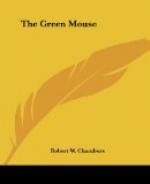It is sufficient to say of this novel that more than five million people have read it. It has taken a permanent place among the best fiction of the period.
SPECIAL MESSENGER
is the title of Mr. Chambers’s novel just preceding “The Danger Mark.” It is the romance of a young woman spy and scout in the Civil War. As a special messenger in the Union service, she is led into a maze of critical situations, but her coolness and bravery and winsome personality always carry her on to victory. The story is crowded with dramatic incident, the roar of battle, the grim realities of war; and, at times, in sharp contrast, comes the tenderest of romance. It is written with an understanding and sympathy for the viewpoint of the partisans on both sides of the conflict.
THE RECKONING
is a novel of the Revolutionary War. It is the fourth, chronologically, of a series of which “Cardigan” and “The Maid-at-Arms” were the first two. The third has not yet been written. These novels of New York in the Revolutionary days are another striking example of the enthusiasm which Mr. Chambers puts into his work. To write an accurate and successful historical novel, one must be a historian as well as a romancer. Mr. Chambers is an authority on New York State history during the Colonial period. And, if the hours spent in poring over old maps and reading up old records and journals do not show, the result is always apparent. The facts are not obtrusive, but they are there, interwoven in the gauzy woof of the artist’s imagination. That is why these romances carry conviction always, why we breathe the very air of the period as we read them.
IOLE
Another splendid example of the author’s versatility is this farcical, humorous satire on the art nouveau of to-day, Mr. Chambers, with all his knowledge of the artistic jargon, has in this little novel created a pious fraud of a father, who brings up his eight lovely daughters in the Adirondacks, where they wear pink pajamas and eat nuts and fruit, and listen to him while he lectures them and everybody else on art. It is easy to imagine what happens when several rich and practical young New Yorkers stumble upon this group. Everybody is happy in the end.
One might run on for twenty books more, but there is not space enough more than to mention “The Tracer of Lost Persons,” “The Tree of Heaven,” “Some Ladies in Haste,” and Mr. Chambers’s delightful nature books for children, telling how Geraldine and Peter go wandering through “Outdoor-Land,” “Mountain-Land,” “Orchard-Land,” “River-Land,” “Forest-Land,” and “Garden-Land.” They, in turn, are as different from his novels in fancy and conception as each of his novels from the other.




